
 It is the renaissance. Fine art is in demand and wealthy nobles are looking to spend their family’s coin. You, a rich merchant, is of course only too happy to take advantage of these fine folks. You will use your resources to acquire mines, transportation methods and artisans who can turn these raw gems into profitable jewels.
It is the renaissance. Fine art is in demand and wealthy nobles are looking to spend their family’s coin. You, a rich merchant, is of course only too happy to take advantage of these fine folks. You will use your resources to acquire mines, transportation methods and artisans who can turn these raw gems into profitable jewels.
That’s the theme for today’s review of Splendor. This easy to learn game made waves this year when it was nominated for the prestigious Spiel des Jahres award. Ultimately, the game fell short of winning this coveted prize, but that didn’t stop it from flying off the shelves. Is Splendor a game that needs to be in your library? Let’s find out!
Splendor is a card drafting and set collection game for 2-4 players that takes about 30 minutes to play. Splendor plays best with 3-4 players.
Game Overview:
Splendor is, at its heart, an engine building game. The main focus of the game will be acquiring development cards by spending your gems (chips). Every card you buy makes it easier to acquire future cards and may also provide you with prestige points (victory points). The key is that these purchased cards allow players to buy subsequent development cards for a lesser cost. Gets your engine going and be the first player to 15 prestige points and you win.
Game Components:
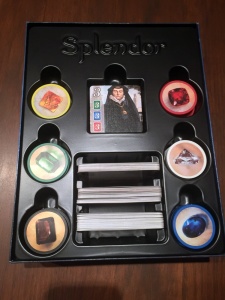
While Splendor only has a few different components, they are all exceptionally made. The best part of Splendor is the gem tokens. They come pre-stickered (thank God) in 6 different colors and have a very good weight to them. They are about the size and thickness of poker chips, so they feel very natural in your hand and I find myself constantly fiddling with them during a game.
Also included are 90 development cards of three different levels. Each level of card is increasing in cost and features progressively different artwork. Level 1 depicts gem mines, level 2 the transpiration and cutting, and level 3 cards are the gem shops. The card stock its self is good quality and should hold up to repeated plays.
Finally there are 10 noble tiles included in the game. These are bonuses players can strive for during the game to score a little extra prestige. The included rulebook clocks in at a whole 4 pages, including the cover, and was overall very easy to learn the game from.
Finally I should note that the box is oddly very big for the components inside. I’m guessing it was due to a cost saving measure, but the box could have easily been half the size it is.
How to Play:
If it takes you more than 5 minutes to learn/teach how to play Splendor, you are probably reading the wrong rulebook. To setup the game, divide the six gem tokens into stacks based on their color. The three levels of development cards are shuffled and 4 cards from each stack are drawn, forming a 4×4 grid. Finally, a number of noble tiles (number of players +1) are randomly dealt out and the rest are returned to the box.
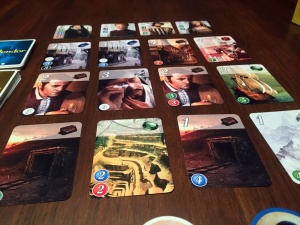
To begin the game, one player takes their turn and the rest of the players take theirs in a clockwise manner.
On a players turn, they can perform one of these four different actions:
• Take 3 gem tokens of different colors
• Take 2 gem tokens of the same color.
• Take one development card into your hand and one gold token (gold tokens are wild).
• Purchase one development card from the table or your hand. Each card has a number of icons that list the color and quantity of gems needed to purchase it. Once purchased, the gem icon at the top of the card will give a discount on future purchases in that color.
For example: if a player has 2 diamond mines and wants to purchase a card that costs 2 diamonds and 1 emerald, they only have to spend one emerald gem token.
A player can never have more than 10 tokens in their stash, or three cards in their hand.
Finally, if at the end of the turn, a player has enough gem cards to equal the quantity and type of a Nobel card, they collect it and add it to their prestige score.
Once a player hits 15 prestige points, the game ends at the end of the current round. The player with the most points wins.
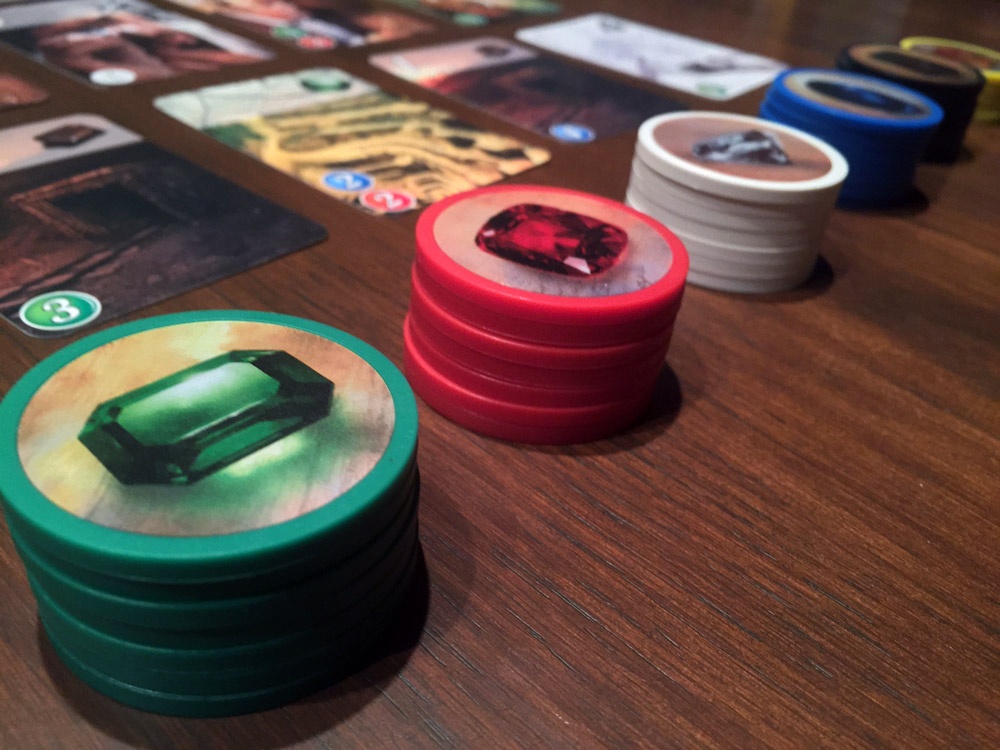
Game Experience:
As I mentioned earlier, Splendor is a very easy game to teach and learn. I think this game can easily make the jump into the gateway games category. The rules are naturally intuitive with the most difficult to learn being the discount mechanic (which is not even that hard). In general, turns should go by quickly and most people will know what they want to do on their turn.
One of the nice things about Splendor is there is a lot of open information. Players can look around and see what chips their opponents are hoarding and make educated guesses as to what card they are shooting for. If you can guess correctly, then your game play turn can come down to drawing chips to help you or reserving the card you know your opponent has their eye on. This is really where the main part of player interaction comes from in Splendor. Denying your opponent the card you know they’ve been saving up a few turns for can be very satisfying to the little devil in all of us.
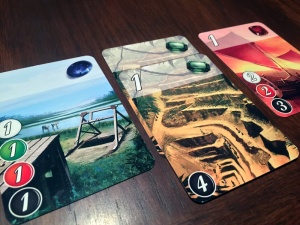
To go in hand with all that open information is the low amount of luck in Splendor. Each player has all the same options available on their turn. The only time luck factors in is what card is drawn to replace a purchased development card. If someone has been going heavy on the diamond minds, drawing a card that requires diamonds will put them ahead of the curve. But other than that, Splendor is all what you can make of it.
But regardless, luck is usually not a factor in winning Splendor. It’s all about crafting your engine as efficiently as possible. You want to be able to buy cards, hopefully by spending the least amount of gem tokens possible. Plus, you want to keep your eye on the prize, those tasty noble cards. They are worth 3 points each and can easily swing the tide of a game if you can acquire one of those and a development card on the same turn.
This is also where a veteran Splendor player can trounce a newbie. Knowing how best to use each of your turns is important if you hope to win Splendor. The game is a race game, and there is not much room for wasted actions. This is especially true since there is no catch up mechanic in the game. If you get a nice collection of cards in your tableau, especially ones that are worth prestige points, it could be hard for a player that made early mistakes to catch you.
One of the interesting things about Splendor is its player scaling. With two players, Splendor can be a very strategic game. Blocking your opponent by reserving a card can be just as important a move as claiming a development card you’ve had your eye on. With two players, the race in Splendor should be tight. Once you get up to the 4 player count, Splendor stops being a strategic game and becomes a tactical one instead. The board will change so much between your turns that it’s almost impossible to work out a strategy. You mostly just have to react to what’s available on your turn and hope for the best. With Splendor, all player counts are fun, they just play somewhat differently.
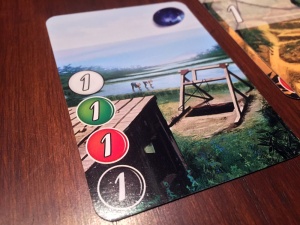
While the mechanics in Splendor are rock solid, the theme is incredibly pasted on. Yes, were collecting gems and buying mines and artisans, but we could just as easily be collecting sheep, comic books, craft beers, seashells or just about anything else you could think of. Don’t go into Splendor expecting to be wowed by its deep theme. You will most likely just say “I spend 3 green tokens” during the game instead of 3 emeralds. Make no mistake; you’re going to bust out Splendor for its game play, not its theme.
And even though the game play in Splendor is great, the game also lacks any real depth. After a few plays, you’ll really have seen all that Splendor has to offer. This isn’t necessarily a bad thing, but I found myself less excited to pull this one off the shelf then when I first got it.
I think that most veteran gamers will enjoy the first few players of Splendor, but then it will probably be regulated to the shelf, only to be brought out when your non-gamer friends come around or when you are looking for a game you can easily jump into. As a family game, or something to play with your friends who still bust out catchphrase when you come over, it’s a fantastic choice. Its accessible nature makes it an easy play and learn. But for your gamer friends, Splendor will at best be a filler game.
Final Thoughts:
Overall I did find Splendor enjoyable. The game mechanics are rock solid (pun intended), the components are well made and it’s a game where we can jump right in and start playing. For me, the pasted on theme, low player interaction, and lack of depth keep it from getting too much table time. I’ll pull it out when I’m looking for a gateway game or when it’s late and I want to play something with minimal setup and learning.
While I don’t have young ones at home, I do think that Splendor make’s a great family game. The rules are easy enough to comprehend and the theme is completely family friendly. While I won’t be pulling Splendor off the shelf every day, it’s a great game to have around for the right moments. If you are looking for a lighter game that you can easily jump into, give this one a try.
If you are interested in getting a copy for yourself, you can get it for about $30.
Final Score: 3.5 Stars – Splendor makes a great gateway game or a heavier filler game, but lacks depth and starts to fade after repeated plays.
 Hits:
Hits:
• Very easy to learn rules
• Quick playing time
• Accessible nature makes it a good gateway game
• Good quality components
Misses:
• Pasted on theme
• Lacks depth, more of a filler game






















An online version of splendor if anyone would like to try out: http://splendor.wwwbgs.com
Features:
– Online multi-players
– Ratings
– Timers
– Live chats
– AI Players
– Plain design
I went to the site you gave, and could not figure out how to get to the game. Only found advertisement for pdf converter. A hint might have been useful unless your just scamming for the converter.
Don’t mistake elegance for a lack of depth! When played one-on-one, Splendor is highly skill intensive and interactive.
Thanks for the comment. I agree, Splendor has an elegant design. But I still think it is lacking in depth. After a number of plays, I sort of feel that I’ve seen all the game has to offer.
My family and I play this game at least weekly and several times a sitting. I think it is great game and you can win with several different strategies. The only change we made is that we play to 20 instead of 15. It is one of our favorite games right now.
I found that the person who starts first almost always end up winning. There must be a fault in this game for this to happen because the first person gets first pick and obviously gets to buy first most of the time.
This game can become addicting. We have changed the rules a bit to beef up the challenge. Fun for all levels of family interaction. Fast enough for everyone. Relaxing, too, if not taken too seriously.
If your opponent goes out (reaches 15+ pts.) and you have on hold a development card and are not able to cash it in, is the points on that card deducted from your score???
Nope, the points are not subtracted from your score.